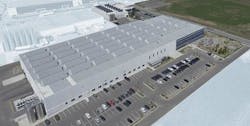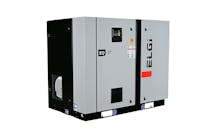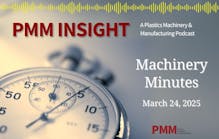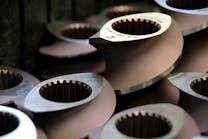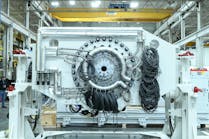When processors plan to build on a greenfield site or to redesign an existing facility, ensuring that it is energy-efficient is a major consideration. The companies that have shared their lessons and perspectives below make machinery and equipment, but the energy-efficient design strategies they used in their facilities can be applied to processing plants, as well.
ATHENA AUTOMATION
In 2015, when Athena Automation Ltd. began designing its new Vaughan, Ontario, facility for making injection molding machines, energy savings and efficiency were top of mind, CEO Harold Luttmann said. "We wanted to build a state-of-the-art industrial building — energy efficient and highly automated — that could be a technology and factory-planning showplace for both injection molding and machinery manufacturing. We expect to recover the additional investment in 10 years through utility cost savings."
The building's roof features north-facing windows for natural light above the assembly hall, and was designed to support a 750-kilowatt solar installation. The office blinds are controlled by the building's automation system and react to the weather, allowing for light and temperature control. Even the plants used in the landscaping were chosen to provide shade to the building when fully grown, and there is a rainwater cistern specifically for landscape maintenance.
Energy-efficient equipment includes natural- gas-fired resin dryers that allow heat reclamation, adiabatic coolers that replace chillers in winter, and HVAC units combined with rotary heat exchangers, Luttmann said.
"Investment in energy-efficient building design and equipment is worthwhile for any business with a long-term outlook," he said. "Especially in the case of greenfield developments, it makes good business sense to include as many energy- efficiency provisions as possible."
Another important consideration, Luttmann said, is using wind, solar and geothermal energy when available.
The Athena Automation facility uses geothermal energy in conjunction with a heat pump in summer and winter, Luttmann said. "During 'shoulder' seasons — spring and fall — we use free cooling" by using outside air, he said.
"We have a combination of in-floor heating/cooling, radiant panels, and air-movement systems to tightly control the building's indoor climate and seamlessly transition between seasons," he said.
The combination of geothermal, air-movement systems and in-floor heating and cooling meets all of the facility's needs, Luttmann added.
WITTMANN BATTENFELD
While energy conservation is essential, overall power demands will nevertheless grow as a facility increases production.
How much power is enough? One never truly knows, said David Canty, Wittmann Battenfeld's facilities, shipping and machine shop manager. The power that meets a manufacturing facility's needs today may be sorely insufficient in the near future.
Wittmann Battenfeld continues to grow, he said, and one of the challenges has been meeting energy demands. The company had to upgrade the entire electrical supply on a number of occasions.
When Wittmann Battenfeld first opened its Torrington, Conn., facility in 2000, 800-amp service was all that was needed to meet its electrical needs. When the company added 15,000 square feet to the facility in 2006, power needs increased, as they did again with an 18,000-square-foot expansion in 2013.
Now the company uses 2,000-amp service. Though there are no immediate plans to add to the facility or to the power availability, Canty doesn't rule anything out.
Plastics processors can run into many of the same issues as the production or size of their plants grows.
With that in mind, Canty recommends that facilities managers meet with the local electricity company to learn how much additional power might be available at a particular location, and what needs to be done internally (such as upgrading electrical boxes) to handle that additional power.
Just as importantly, facilities managers need to consult with zoning officials to see if there are any zoning restrictions that would limit an increase of power at a site.
Facilities managers also can take important steps to conserve energy even as their plants' overall power needs grow, Canty said.
For example, at the Torrington site, Wittmann Battenfeld has converted from metal halo lights to high bay fluorescent lights and is considering LED lighting. Converting to fluorescent cut lighting costs by 40 percent, with another 40 percent savings possible with a conversion to LED, Canty said. The plant also uses sensors to turn off lights automatically.
Phillip Britt, correspondent
pbritt@plasticsmachinerymagazine.com
For more information
Athena Automation Ltd.,Vaughan, Ontario, 905-265-0277, www.athenaautomation.com
Wittmann Battenfeld Inc.,Torrington, Conn., 860-496-9603, www.wittmann-group.com

